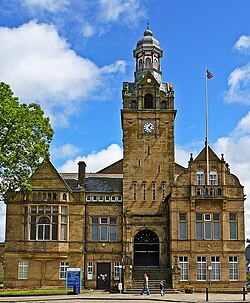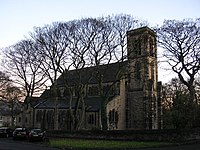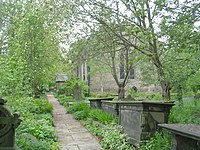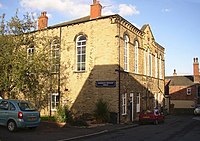Cleckheaton
| Cleckheaton | |
| Yorkshire West Riding | |
|---|---|
 Cleckheaton Town Hall | |
| Location | |
| Grid reference: | SE185256 |
| Location: | 53°43’30"N, 1°43’8"W |
| Data | |
| Population: | 16,622 (2011) |
| Post town: | Cleckheaton |
| Postcode: | BD19 |
| Dialling code: | 01274 |
| Local Government | |
| Council: | Kirklees |
| Parliamentary constituency: |
Batley and Spen |
Cleckheaton is a town in the West Riding of Yorkshire, sitting to the south of Bradford, east of Brighouse, west of Batley and south-west of Leeds. It is at the centre of the Spen Valley and was the major town of its area in its day.
Cleckheaton has a history as a mill town and forms part of the Heavy Woollen District.
Contents
History
Early history
The Spen Valley was once heavily wooded. Evidence of human habitation in Mesolithic and Neolithic times has been found in the area. Roman remains have been found in the valley and it is thought that roads from York to Chester, and from settlements in Halifax and Wakefield, passed through Cleckheaton.[1]
Cleckheaton was in the ancient parish of Birstall. A chapel of ease, known as the White Chapel (later Whitechapel) was established.[2]
Textile working
Mediaeval tax returns show the recent deviation from farming as the major sources of wealth in the area: cmmerce instead centred on textiles and included dyeing, weaving and fulling. Common surnames in the area nowadays still recall these early trades: Lister (dyer), Webster (weaver), Walker (fuller).[3]
After the Reformation, Kirklees Priory was dissolved and its lands sold to the upcoming famlies of the area. By 1570, at the time of the Rising of the Northern Earls, the last of the old Norman noble families had been swept away: Sir John Neville went into exile and forfeited his estate and Thomas Hussey (heir to the de Tilly family of Oakwell Hall) was imprisoned in the Tower of London for some time before being pardoned.[4]
By the 17th century, land-owning farmers were on the wane and textile workers were becoming more prosperous. During the Civil War, the clothiers were on the Parliamentarian side and the landlords on the King's. The latter achieved victories in the local area, at the Battle of Adwalton Moor about a mile east of Birkenshaw and the Siege of Bradford, before the Parliamentarians took control of the area.[5]
Nonconformity
After the Restoration in 1660, Anglicanism was reintroduced. However, many people had found Puritan teachings more to their taste, and it took many years to re-install an Anglican vicar to Whitechapel. Despite the draconian nonconformist laws, there were many nonconformist meeting houses and nonconformity flourished; a fifth of the population of the Birstall Parish was estimated to be nonconformist. Quakers were widespread, and even now a number of 17th and 18th century Quaker burial grounds remain in the area. In the 18th century, Presbyterianism was widespread, but then it lost a large minority of its flock to Unitarianism and to the Baptist church. Methodism also flourished from the 1740s after visits from John Wesley and Charles Wesley, as did the Moravian Church. Indeed, John Wesley visited Birstall some 40 times.[6]
In spite of the religious strength in the valley, the inhabitants were somewhat unconventional and still went to astrologers, quack doctors and prophets. Local religious leaders included people like Eli Collins, the "Wizard of Wyke", and Alvery Newsome, the "Wise Man of Heckmondwike".[7]
Industrial Revolution
In 1804 the Reverend Hammond Roberson, annoyed that the administration of Liversedge was disorganised, promoted a system of reform (the select vestry) which quickly spread to Cleckheaton and Heckmondwike. In 1810, after his wife's death, Roberson turned his attention to church building in the area. In 1818 Parliament voted £1 million for the building of new churches in the country, and Roberson was able to secure funding to build Cleckheaton Church: St John the Evangelist in Church Street.[8]
Spen Valley
By the mid 19th century the Spen Valley entered its golden era. In 1800 children were paid starvation wages for putting staples into leather for carding wool, but by 1838 there were eleven carding factories in Cleckheaton and by 1893 the town was recognised as the carding capital of the world.[9]
20th century
Around 1900, many large and expensive buildings were erected and became symbols of the area's wealth; massive chapels and a new grammar school were built in Cleckheaton, and to mark the new municipal authorityof which the town was the centre. Cleckheaton Town Hall was built in 1892, paid for in part by public subscription.[10]
In 1903, Lion Confectionery began making "Midget Gems" in Cleckheaton, and 1904 saw the opening of the Phelon & Moore (Panther) motorcycle factory in the town, soon followed by a car factory.[11] BBA (formerly British Belting & Asbestos), the large asbestos, friction material, and conveyor belting firm, built its headquarters at Moorend, where they manufactured automotive disc brake pads under the Mintex banner. A tourist industry developed to serve visitors to the area aware of its connection to Charlotte Brontë's novel Shirley and Luddite attacks. The philanthropic Mowatt family paid for Cleckheaton Library.[12]
Cleckheaton railway station
Cleckheaton railway station closed to passenger traffic in 1965 and to goods four years later.
In 1972, a singular case was heard at Wakefield Crown Court. A Dewsbury man was accused of, as counsel for the prosecution put it, effectively stealing the station. British Rail had contracted for the clearing of the site; part of the deal was that the contractors would sell and retain the proceeds from disposal of the materials and scrap. On arrival, the contractors discovered that the station and most of the material were already gone. It transpired that the defendant had been contracted by another firm to clear the site, had been advanced a sum for hire of plant, and had spent three weeks clearing the site. Subsequent efforts to trace the second firm failed, and the court found the man not guilty, deciding that he had been duped and left significantly out of pocket.[13]
Geography
Cleckheaton is at the centre of a number of villages which together form the Spen Valley: Oakenshaw, East Bierley, Hunsworth, Birkenshaw, Drub, Gomersal, Little Gomersal, Littletown, Millsbridge, Liversedge, Roberttown, Hartshead, Clifton, Hightown, Heckmondwike and Scholes. The town itself is made up of areas such as Moorend, Whitechapel, Whitcliffe, Moorbottom, Moorside, the Marsh and Rawfolds.[14]
Sports
Cleckheaton Sports Club, based at Moorend, is the home of the town's rugby union team, cricket team and bowls club.
- Bowls: Cleckheaton Sports Bowls Club
- Cricket:
- Cleckheaton Cricket Club
- Spen Victoria
- Gomersal CC
- Hartshead Moor CC
- East Bierley CC
- Rugby: Cleckheaton RUFC
- Football: Liversedge F.C.
Outside links
| ("Wikimedia Commons" has material about Cleckheaton) |
References
- ↑ "Whitechapel Road Cleckheaton: Archaeological Evaluation". West Yorkshire Archaeological Services. 1 December 2015. p. 4. https://www.kirklees.gov.uk/beta/planning-policy/pdf/site-specific/Whitehall-Road-archaeological-evaluation.pdf.
- ↑ @[1]
- ↑ "The Returns for the West Riding of the county of York of the Poll Tax laid in the second year of the reign of King Richard the Second". National Archives. https://www.nationalarchives.gov.uk/e179/details.asp?piece_id=23796&doc_id=18439&doc_ref=E179/206/49.
- ↑ Birstall, Gomersal, and Heckmondwike. The Publications of the Thoresby Society. p. 30. https://archive.org/stream/thoresbypt126thoruoft/thoresbypt126thoruoft_djvu.txt. Retrieved 8 May 2022.
- ↑ MacKenzie, John (2020). "Battle of Adwalton Moor". https://www.britishbattles.com/english-civil-war/battle-of-adwalton-moor/.
- ↑ "Birstall". UK Wells. https://ukwells.org/wells/birstall.
- ↑ Peel, Frank (1893). Spen Valley, Past and Present. Senior and Company. p. 273. https://books.google.com/books?id=qpkMAQAAMAAJ&pg=PA273.
- ↑ Port, M. H. (2006). Six Hundred New Churches. A study of the Church Building Commission, 1816–1856. Spire Books.
- ↑ Gillian Cookson (1998) The Mechanization of Yorkshire Card-Making, Textile History, 29:1, 41–61
- ↑ "History of Cleckheaton Town Hall". https://www.kirklees.gov.uk/beta/town-halls/pdf/cleckheaton-town-hall-history.pdf.
- ↑ "Belle Vue Grammar School". Bradford Timeline. http://www.bradfordtimeline.co.uk/190049.htm.
- ↑ "Letter: A first for the Friends of Cleckheaton Library". Dewsbury Reporter. 15 December 2014. https://www.dewsburyreporter.co.uk/news/opinion/letters/letter-a-first-for-the-friends-of-cleckheaton-library-2252394.
- ↑ Body, Geoffrey: Railway Oddities, Tempus, 2007 ISBN 978-0-7524-4399-7
- ↑ "Area Profiles". Kirklees Council. https://www.kirklees.gov.uk/beta/information-and-data/area-and-ward-profiles.aspx.




